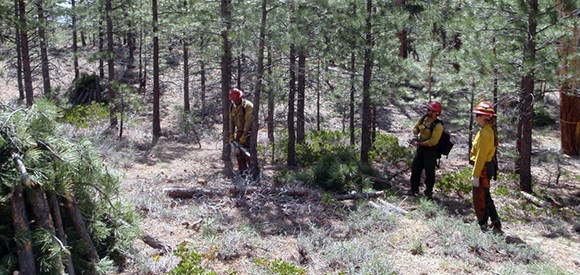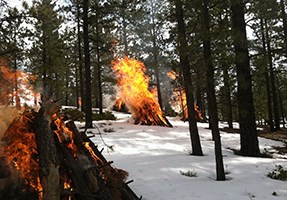Last updated: January 13, 2017
Article
Bryce Canyon National Park Completes Fuels Reduction Project
On October 19, 2013, Bryce Canyon National Park completed a major fuels reduction project around the historic Bryce Canyon Lodge and its associated cabins and infrastructure. This 295-acre project began in May 2012 and was designed to reduce the fuel loading and stand density of ponderosa pine and return the forest to a more natural state, while also reducing the risk to park infrastructure.

In 2011, numerous structures burned in wildfires throughout the West. These losses initiated an updated structure assessment survey by the NPS to evaluate the Firewise defensible space standards that were adopted by the agency and to determine if these standards were sufficient. Wildland fire modules from Zion and Saguaro National Parks and Bandelier National Monument were brought in to initiate the assessments. Each structure in the park was surveyed and photographed. A report outlined the work needed to meet Firewise standards for the structures.
In the past, fire management officials at Bryce Canyon have used low intensity prescribed fire to achieve fuel reduction objectives, but because of the project area’s close proximity to Bryce Canyon Lodge and its visitors, mechanical methods were used. This was the largest mechanical fuel reduction project in the park’s history.

Ponderosa pine stands were thinned and limbed up using chainsaws from an overcrowded density of approximately 200-300 trees per acre to a more natural density of 20-50 trees. This fuel reduction method eliminated the risks that a prescribed fire might have, thus minimizing impacts to park visitors. The thinned debris was then pushed into piles that were burned during the winter of 2012-2013 when snow covered the ground and reduced the risk of escape. A total of 280 piles were burned that winter. Crews raked the dense accumulation of pine needles away from the structures to reduce the risk from wildfire.
Another innovative aspect of this project was that during the thinning process, some of the larger ponderosa pine trees were cut up into firewood-sized pieces and sold to the public through a lottery system. More than 25 cords of firewood were sold at $25.00 per cord. Although profiting from the sale and distribution of resources in a national park is prohibited, these funds instead went toward volunteer needs and projects to improve and protect park ecosystems. One of the added benefits of contributing to the local community through the firewood lottery is the reduced impact from long duration prescribed or wildland fires now that the fuel load is less.
The process of mechanical thinning and firewood distribution that fire managers used will reduce the risks from wildland fire and help perpetuate the natural and cultural resource values for which Bryce Canyon National Park was established.
Contact: David Eaker, fire communication and education specialist
Email: e-mail us
Phone: (435) 772-7811
